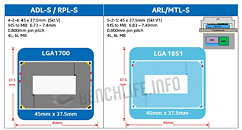
AMD Ryzen 5 7400F De-Lid Reveals Thermal Paste Instead of STIM
Priced at the equivalent of $116, the China-exclusive Ryzen 5 7400F is a 6-core/12-thread processor powered by the older "Zen 4" microarchitecture, but which is based on the "Raphael" MCM, giving it a comprehensive PCIe Gen 5 I/O (as opposed to designing such a chip based on the "Phoenix Point" monolithic silicon with its PCIe Gen 4 I/O). The chip benefits from the full 32 MB on-die L3 cache being enabled on the "Zen 4" CCD, besides the full 1 MB per core L2 cache, and that I/O, but misses out on the iGPU. At its price, the 7400F is attracting a segment of value-conscious gamers.
To bring this chip at its price point, AMD had to cut costs somewhere, and Chinese PC enthusiast "Melon Master" soon found out where. On de-lidding (removing IHS) of the Ryzen 5 7400F, it was found that the chip does not use a soldered TIM like the other Ryzen 7000 series "Raphael" processors, instead using more cost-effective thermal paste, as is common in entry-level chips from both AMD and Intel. Harukaze5719 comments that this could be the reason the chip has a fairly noticeable Cinebench R23 performance delta against the Ryzen 5 7500F that's globally available, and has STIM, but is priced at $145. The 7400F and 7500F share the same base frequency of 3.70 GHz, but while the former boosts up to 4.70 GHz, the latter goes all the way up to 5.00 GHz.
To bring this chip at its price point, AMD had to cut costs somewhere, and Chinese PC enthusiast "Melon Master" soon found out where. On de-lidding (removing IHS) of the Ryzen 5 7400F, it was found that the chip does not use a soldered TIM like the other Ryzen 7000 series "Raphael" processors, instead using more cost-effective thermal paste, as is common in entry-level chips from both AMD and Intel. Harukaze5719 comments that this could be the reason the chip has a fairly noticeable Cinebench R23 performance delta against the Ryzen 5 7500F that's globally available, and has STIM, but is priced at $145. The 7400F and 7500F share the same base frequency of 3.70 GHz, but while the former boosts up to 4.70 GHz, the latter goes all the way up to 5.00 GHz.





























































